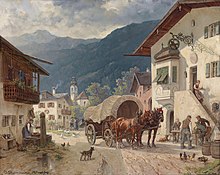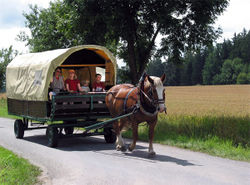Covered wagon
A covered wagon is a traditional horse or ox- drawn wagon with a mostly arched tarpaulin roof, which got different designs in the course of development.
Equipment and use
Covered wagons are used today in various countries as campers for vacationers, in Germany mainly for group trips with an excursion character. Instead of horses, for example in carnival parades , tractors or converted trucks are often used as tractors. Today, covered wagon trips are also used for didactic purposes, both in teacher training and in the education of children and young people.
The equipment depends on the respective purpose: The interior design of camping covered wagons is often the same as that of simple mobile homes , while covered wagons for group trips usually have two long benches arranged on the long sides of the wagon with a long table in the middle. Smaller covered wagons can often be converted into a normal wagonette by removing the tarpaulin and the rods .
Historic covered wagons
Historically, covered wagons played an important role in the development and settlement of the North American West : the family's belongings were transported over long distances through impassable areas with the help of covered wagons. There were usually about five people per covered wagon. They were drawn by oxen or horses, one-horse or two-horse:
Since 1754 the classic covered wagon known from numerous western films , the relatively lightly built so-called "Prairie Schooner", has been traveling with the settler families in western North America.
It was supplemented by the so-called Conestoga , a heavy truck pulled by four to six horses that was built by German emigrants in Pennsylvania during the colonial days of the USA .
In Europe a category "covered wagon" was created, which was developed by the so-called "travelers" and became known as the "gypsy wagon" . Instead of a tarpaulin, it consisted largely of a solid shell that provided better protection against wind and weather. Identical replicas are still used today by tourists , for example in Connemara ( Ireland ), as a leisurely, adventurous vacation vehicle.

But also traders and travelers used typical covered wagons to get around on the streets of Europe, as the Austrian painter Désiré Thomassin (1858–1933) captured in a picture with an Alpine landscape.
Tourist covered wagon
In our time covered wagon trips in Germany and other countries such as Ireland , Hungary or the Czech Republic are mainly offered as adventure holidays, whereby the vehicles are usually equipped with simple cooking and sleeping equipment.
When school classes and youth groups go out, the covered wagon is often only used to transport luggage and to pick up injured or foot-tired participants on a long hike. In this way, youth groups and families can also take younger children and equipment such as tents, cooking utensils and food with them on an adventure trip lasting several days .
On certain occasions such as “ First May ”, “ Father's Day ”, Mardi Gras or family celebrations, day trips for small groups outdoors with games, singing and campfire experiences are organized, with the covered wagon acting as a means of transport and weatherproof accommodation.
literature
- Ministry f. Kultus und Sport BaWü (ed.): School trip with the covered wagon , In: Schulzeit 4/1987 page 9 ff
- Frieder Rothe: The covered wagon - activities for youth groups , 2nd edition, Heidenheim 1978
- Siegbert A. Warwitz, Anita Rudolf, Josef Wagner: Adventure covered wagon , In: Dies. (Ed.): Project teaching in schools and universities - PU 5 (1989) of the media series on interdisciplinary teaching, Karlsruhe 1980 ff (72 pages)
- Stiftung Warentest (ed.): Periodical test : wagon, adventure for a long weekend , In: test 7/1983 page 647-652
Web links
Individual evidence
- ^ Frieder Rothe: The covered wagon - activities for youth groups , 2nd edition, Heidenheim 1978
- ^ Stiftung Warentest (Ed.): Test magazine : Covered wagon vacation , adventure for a long weekend , In: test 7/1983, pages 647-652
- ↑ Ministry f. Kultus und Sport BaWü (ed.): School trip with the covered wagon , In: Schulzeit 4/1987 page 9 ff
- ^ Frieder Rothe: The covered wagon - activities for youth groups , 2nd edition, Heidenheim 1978
- ^ Siegbert A. Warwitz, Anita Rudolf, Josef Wagner: Adventure covered wagon , In: Dies. (Ed.): Project teaching in schools and universities - PU 5 (1989) of the media series on interdisciplinary teaching, Karlsruhe 1980ff




